Employee Relations Report: Analysis of ALDI's Practices
VerifiedAdded on 2020/07/23
|14
|4956
|83
Report
AI Summary
This report provides a comprehensive analysis of employee relations, using ALDI as a case study to illustrate key concepts. The report begins by exploring unitary and pluralistic frames of reference, examining the roles of managers, employees, trade unions, and third parties. It then investigates the impact of changes in trade unionism on employee relations within ALDI. The report further delves into conflict resolution procedures, negotiation strategies, and the key features of effective employee relations. Additionally, it examines the influence of the EU on industrial democracy in the UK and compares different methods of employee participation. Finally, it assesses the impact of human resource management on employee relations, providing a well-rounded understanding of the subject. The report is a valuable resource for students studying leadership and management and is available on Desklib.
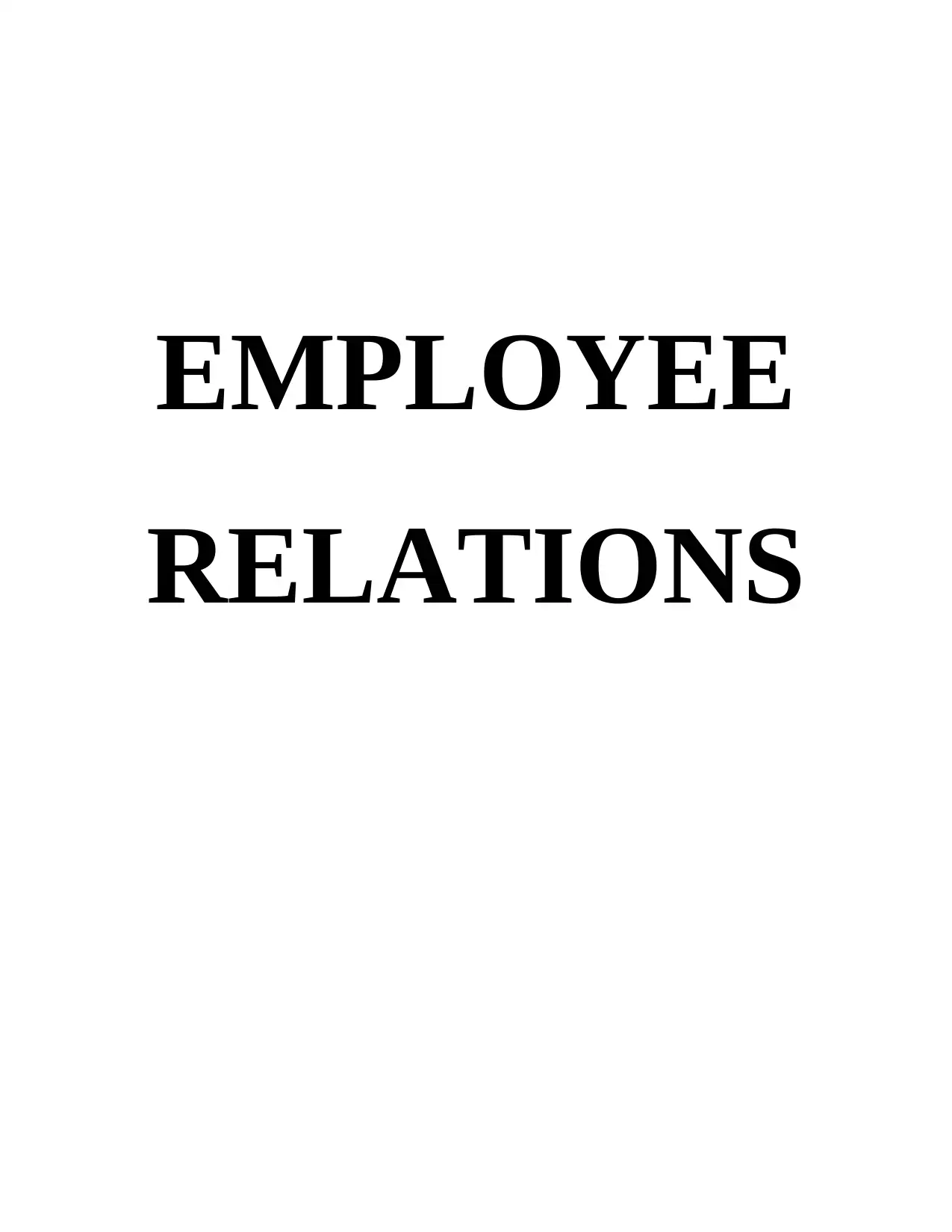
EMPLOYEE
RELATIONS
RELATIONS
Paraphrase This Document
Need a fresh take? Get an instant paraphrase of this document with our AI Paraphraser

TABLE OF CONTENTS
INTRODUCTION...........................................................................................................................1
TASK 1............................................................................................................................................1
1.1 Unitary and Pluralistic Frames of Reference....................................................................1
1.2 Effects of changes in trade unionism for employees relations.........................................2
1.3 Main players in employee relations and their role...........................................................3
TASK 2............................................................................................................................................4
2.1 Procedures for dealing with conflicting situations...........................................................4
2.2 Key Features of employee relations.................................................................................5
2.3 Effectiveness of the procedures used in a conflicted situation........................................5
TASK 3............................................................................................................................................6
3.1 Role of negotiation in collective bargaining....................................................................6
3.2 Impact of negotiation strategy for a situation...................................................................7
TASK 4............................................................................................................................................8
4.1 How EU influenced industrial democracy in UK.............................................................8
4.2 Comparison of different methods of gaining employee participation and involvement in
the decision making process in the organisation....................................................................9
4.3 Impact of human resource management on employee relations....................................10
CONCLUSION..............................................................................................................................10
REFERENCES..............................................................................................................................11
INTRODUCTION...........................................................................................................................1
TASK 1............................................................................................................................................1
1.1 Unitary and Pluralistic Frames of Reference....................................................................1
1.2 Effects of changes in trade unionism for employees relations.........................................2
1.3 Main players in employee relations and their role...........................................................3
TASK 2............................................................................................................................................4
2.1 Procedures for dealing with conflicting situations...........................................................4
2.2 Key Features of employee relations.................................................................................5
2.3 Effectiveness of the procedures used in a conflicted situation........................................5
TASK 3............................................................................................................................................6
3.1 Role of negotiation in collective bargaining....................................................................6
3.2 Impact of negotiation strategy for a situation...................................................................7
TASK 4............................................................................................................................................8
4.1 How EU influenced industrial democracy in UK.............................................................8
4.2 Comparison of different methods of gaining employee participation and involvement in
the decision making process in the organisation....................................................................9
4.3 Impact of human resource management on employee relations....................................10
CONCLUSION..............................................................................................................................10
REFERENCES..............................................................................................................................11
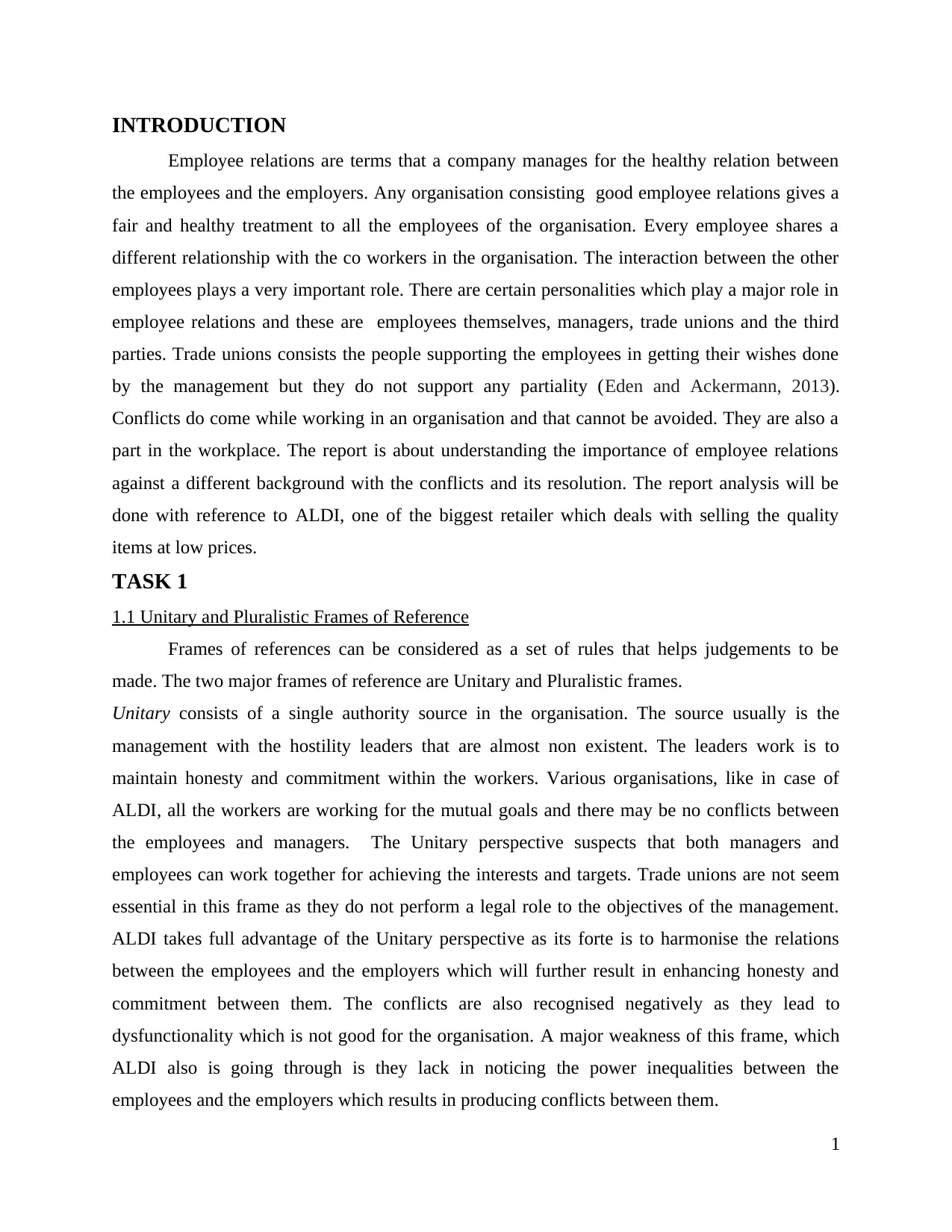
INTRODUCTION
Employee relations are terms that a company manages for the healthy relation between
the employees and the employers. Any organisation consisting good employee relations gives a
fair and healthy treatment to all the employees of the organisation. Every employee shares a
different relationship with the co workers in the organisation. The interaction between the other
employees plays a very important role. There are certain personalities which play a major role in
employee relations and these are employees themselves, managers, trade unions and the third
parties. Trade unions consists the people supporting the employees in getting their wishes done
by the management but they do not support any partiality (Eden and Ackermann, 2013).
Conflicts do come while working in an organisation and that cannot be avoided. They are also a
part in the workplace. The report is about understanding the importance of employee relations
against a different background with the conflicts and its resolution. The report analysis will be
done with reference to ALDI, one of the biggest retailer which deals with selling the quality
items at low prices.
TASK 1
1.1 Unitary and Pluralistic Frames of Reference
Frames of references can be considered as a set of rules that helps judgements to be
made. The two major frames of reference are Unitary and Pluralistic frames.
Unitary consists of a single authority source in the organisation. The source usually is the
management with the hostility leaders that are almost non existent. The leaders work is to
maintain honesty and commitment within the workers. Various organisations, like in case of
ALDI, all the workers are working for the mutual goals and there may be no conflicts between
the employees and managers. The Unitary perspective suspects that both managers and
employees can work together for achieving the interests and targets. Trade unions are not seem
essential in this frame as they do not perform a legal role to the objectives of the management.
ALDI takes full advantage of the Unitary perspective as its forte is to harmonise the relations
between the employees and the employers which will further result in enhancing honesty and
commitment between them. The conflicts are also recognised negatively as they lead to
dysfunctionality which is not good for the organisation. A major weakness of this frame, which
ALDI also is going through is they lack in noticing the power inequalities between the
employees and the employers which results in producing conflicts between them.
1
Employee relations are terms that a company manages for the healthy relation between
the employees and the employers. Any organisation consisting good employee relations gives a
fair and healthy treatment to all the employees of the organisation. Every employee shares a
different relationship with the co workers in the organisation. The interaction between the other
employees plays a very important role. There are certain personalities which play a major role in
employee relations and these are employees themselves, managers, trade unions and the third
parties. Trade unions consists the people supporting the employees in getting their wishes done
by the management but they do not support any partiality (Eden and Ackermann, 2013).
Conflicts do come while working in an organisation and that cannot be avoided. They are also a
part in the workplace. The report is about understanding the importance of employee relations
against a different background with the conflicts and its resolution. The report analysis will be
done with reference to ALDI, one of the biggest retailer which deals with selling the quality
items at low prices.
TASK 1
1.1 Unitary and Pluralistic Frames of Reference
Frames of references can be considered as a set of rules that helps judgements to be
made. The two major frames of reference are Unitary and Pluralistic frames.
Unitary consists of a single authority source in the organisation. The source usually is the
management with the hostility leaders that are almost non existent. The leaders work is to
maintain honesty and commitment within the workers. Various organisations, like in case of
ALDI, all the workers are working for the mutual goals and there may be no conflicts between
the employees and managers. The Unitary perspective suspects that both managers and
employees can work together for achieving the interests and targets. Trade unions are not seem
essential in this frame as they do not perform a legal role to the objectives of the management.
ALDI takes full advantage of the Unitary perspective as its forte is to harmonise the relations
between the employees and the employers which will further result in enhancing honesty and
commitment between them. The conflicts are also recognised negatively as they lead to
dysfunctionality which is not good for the organisation. A major weakness of this frame, which
ALDI also is going through is they lack in noticing the power inequalities between the
employees and the employers which results in producing conflicts between them.
1
⊘ This is a preview!⊘
Do you want full access?
Subscribe today to unlock all pages.

Trusted by 1+ million students worldwide
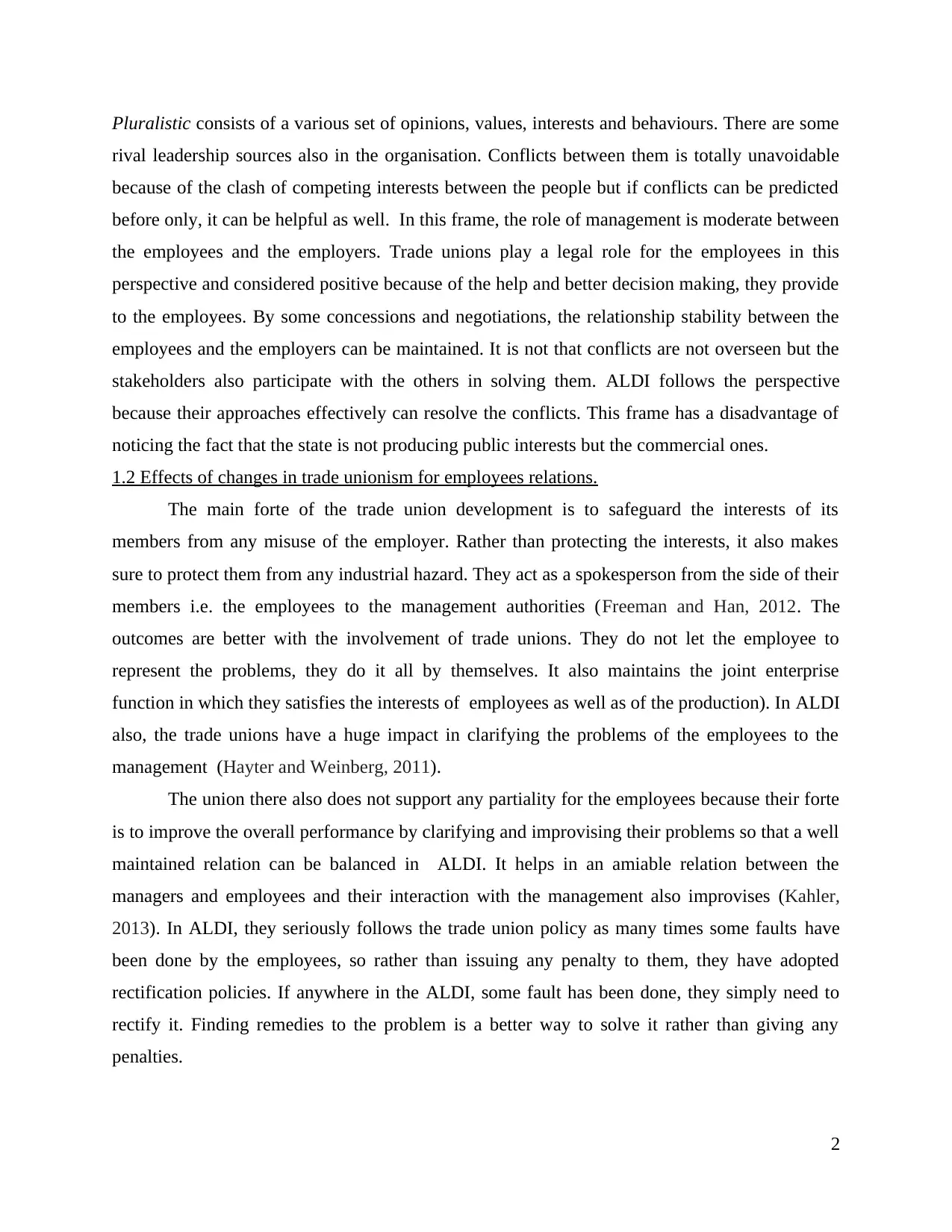
Pluralistic consists of a various set of opinions, values, interests and behaviours. There are some
rival leadership sources also in the organisation. Conflicts between them is totally unavoidable
because of the clash of competing interests between the people but if conflicts can be predicted
before only, it can be helpful as well. In this frame, the role of management is moderate between
the employees and the employers. Trade unions play a legal role for the employees in this
perspective and considered positive because of the help and better decision making, they provide
to the employees. By some concessions and negotiations, the relationship stability between the
employees and the employers can be maintained. It is not that conflicts are not overseen but the
stakeholders also participate with the others in solving them. ALDI follows the perspective
because their approaches effectively can resolve the conflicts. This frame has a disadvantage of
noticing the fact that the state is not producing public interests but the commercial ones.
1.2 Effects of changes in trade unionism for employees relations.
The main forte of the trade union development is to safeguard the interests of its
members from any misuse of the employer. Rather than protecting the interests, it also makes
sure to protect them from any industrial hazard. They act as a spokesperson from the side of their
members i.e. the employees to the management authorities (Freeman and Han, 2012. The
outcomes are better with the involvement of trade unions. They do not let the employee to
represent the problems, they do it all by themselves. It also maintains the joint enterprise
function in which they satisfies the interests of employees as well as of the production). In ALDI
also, the trade unions have a huge impact in clarifying the problems of the employees to the
management (Hayter and Weinberg, 2011).
The union there also does not support any partiality for the employees because their forte
is to improve the overall performance by clarifying and improvising their problems so that a well
maintained relation can be balanced in ALDI. It helps in an amiable relation between the
managers and employees and their interaction with the management also improvises (Kahler,
2013). In ALDI, they seriously follows the trade union policy as many times some faults have
been done by the employees, so rather than issuing any penalty to them, they have adopted
rectification policies. If anywhere in the ALDI, some fault has been done, they simply need to
rectify it. Finding remedies to the problem is a better way to solve it rather than giving any
penalties.
2
rival leadership sources also in the organisation. Conflicts between them is totally unavoidable
because of the clash of competing interests between the people but if conflicts can be predicted
before only, it can be helpful as well. In this frame, the role of management is moderate between
the employees and the employers. Trade unions play a legal role for the employees in this
perspective and considered positive because of the help and better decision making, they provide
to the employees. By some concessions and negotiations, the relationship stability between the
employees and the employers can be maintained. It is not that conflicts are not overseen but the
stakeholders also participate with the others in solving them. ALDI follows the perspective
because their approaches effectively can resolve the conflicts. This frame has a disadvantage of
noticing the fact that the state is not producing public interests but the commercial ones.
1.2 Effects of changes in trade unionism for employees relations.
The main forte of the trade union development is to safeguard the interests of its
members from any misuse of the employer. Rather than protecting the interests, it also makes
sure to protect them from any industrial hazard. They act as a spokesperson from the side of their
members i.e. the employees to the management authorities (Freeman and Han, 2012. The
outcomes are better with the involvement of trade unions. They do not let the employee to
represent the problems, they do it all by themselves. It also maintains the joint enterprise
function in which they satisfies the interests of employees as well as of the production). In ALDI
also, the trade unions have a huge impact in clarifying the problems of the employees to the
management (Hayter and Weinberg, 2011).
The union there also does not support any partiality for the employees because their forte
is to improve the overall performance by clarifying and improvising their problems so that a well
maintained relation can be balanced in ALDI. It helps in an amiable relation between the
managers and employees and their interaction with the management also improvises (Kahler,
2013). In ALDI, they seriously follows the trade union policy as many times some faults have
been done by the employees, so rather than issuing any penalty to them, they have adopted
rectification policies. If anywhere in the ALDI, some fault has been done, they simply need to
rectify it. Finding remedies to the problem is a better way to solve it rather than giving any
penalties.
2
Paraphrase This Document
Need a fresh take? Get an instant paraphrase of this document with our AI Paraphraser
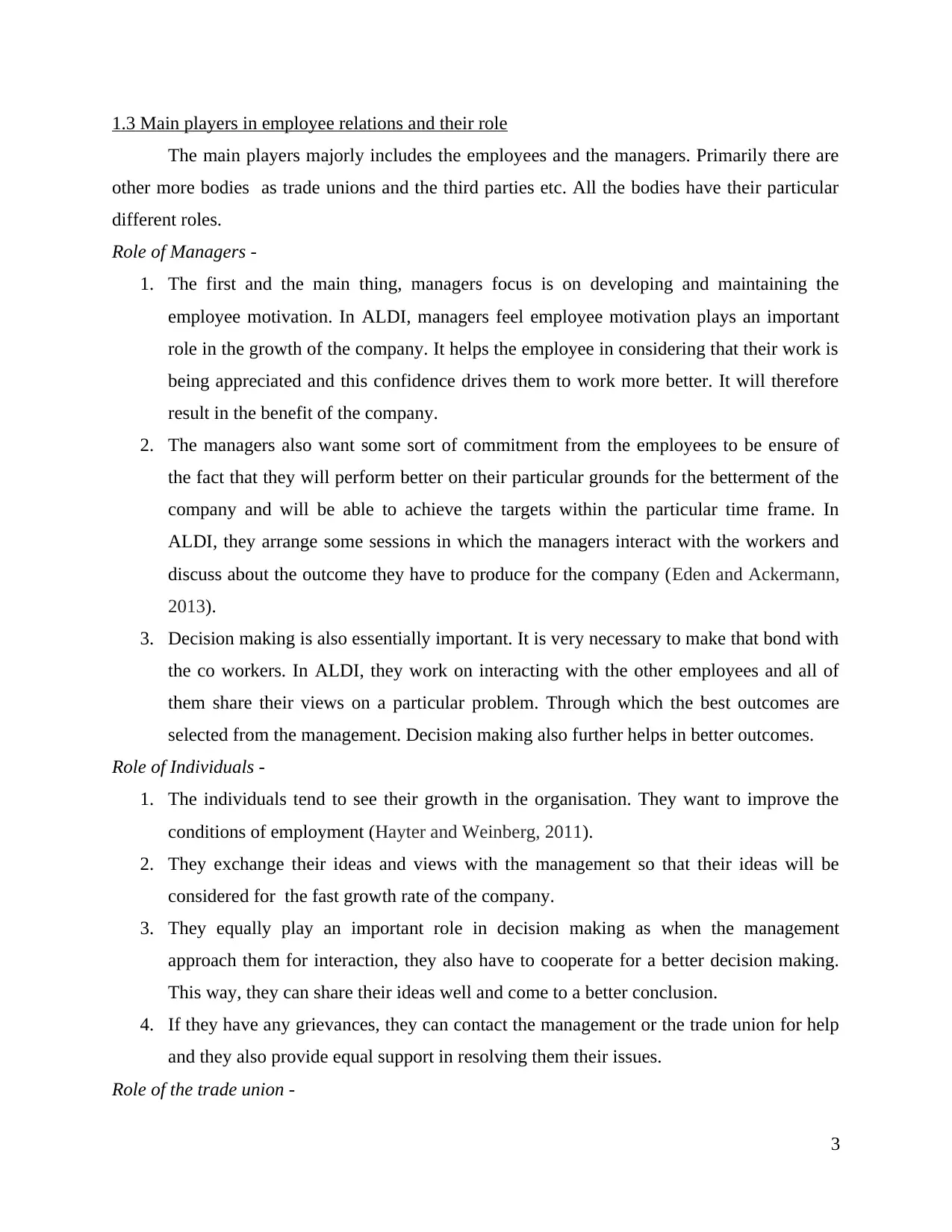
1.3 Main players in employee relations and their role
The main players majorly includes the employees and the managers. Primarily there are
other more bodies as trade unions and the third parties etc. All the bodies have their particular
different roles.
Role of Managers -
1. The first and the main thing, managers focus is on developing and maintaining the
employee motivation. In ALDI, managers feel employee motivation plays an important
role in the growth of the company. It helps the employee in considering that their work is
being appreciated and this confidence drives them to work more better. It will therefore
result in the benefit of the company.
2. The managers also want some sort of commitment from the employees to be ensure of
the fact that they will perform better on their particular grounds for the betterment of the
company and will be able to achieve the targets within the particular time frame. In
ALDI, they arrange some sessions in which the managers interact with the workers and
discuss about the outcome they have to produce for the company (Eden and Ackermann,
2013).
3. Decision making is also essentially important. It is very necessary to make that bond with
the co workers. In ALDI, they work on interacting with the other employees and all of
them share their views on a particular problem. Through which the best outcomes are
selected from the management. Decision making also further helps in better outcomes.
Role of Individuals -
1. The individuals tend to see their growth in the organisation. They want to improve the
conditions of employment (Hayter and Weinberg, 2011).
2. They exchange their ideas and views with the management so that their ideas will be
considered for the fast growth rate of the company.
3. They equally play an important role in decision making as when the management
approach them for interaction, they also have to cooperate for a better decision making.
This way, they can share their ideas well and come to a better conclusion.
4. If they have any grievances, they can contact the management or the trade union for help
and they also provide equal support in resolving them their issues.
Role of the trade union -
3
The main players majorly includes the employees and the managers. Primarily there are
other more bodies as trade unions and the third parties etc. All the bodies have their particular
different roles.
Role of Managers -
1. The first and the main thing, managers focus is on developing and maintaining the
employee motivation. In ALDI, managers feel employee motivation plays an important
role in the growth of the company. It helps the employee in considering that their work is
being appreciated and this confidence drives them to work more better. It will therefore
result in the benefit of the company.
2. The managers also want some sort of commitment from the employees to be ensure of
the fact that they will perform better on their particular grounds for the betterment of the
company and will be able to achieve the targets within the particular time frame. In
ALDI, they arrange some sessions in which the managers interact with the workers and
discuss about the outcome they have to produce for the company (Eden and Ackermann,
2013).
3. Decision making is also essentially important. It is very necessary to make that bond with
the co workers. In ALDI, they work on interacting with the other employees and all of
them share their views on a particular problem. Through which the best outcomes are
selected from the management. Decision making also further helps in better outcomes.
Role of Individuals -
1. The individuals tend to see their growth in the organisation. They want to improve the
conditions of employment (Hayter and Weinberg, 2011).
2. They exchange their ideas and views with the management so that their ideas will be
considered for the fast growth rate of the company.
3. They equally play an important role in decision making as when the management
approach them for interaction, they also have to cooperate for a better decision making.
This way, they can share their ideas well and come to a better conclusion.
4. If they have any grievances, they can contact the management or the trade union for help
and they also provide equal support in resolving them their issues.
Role of the trade union -
3
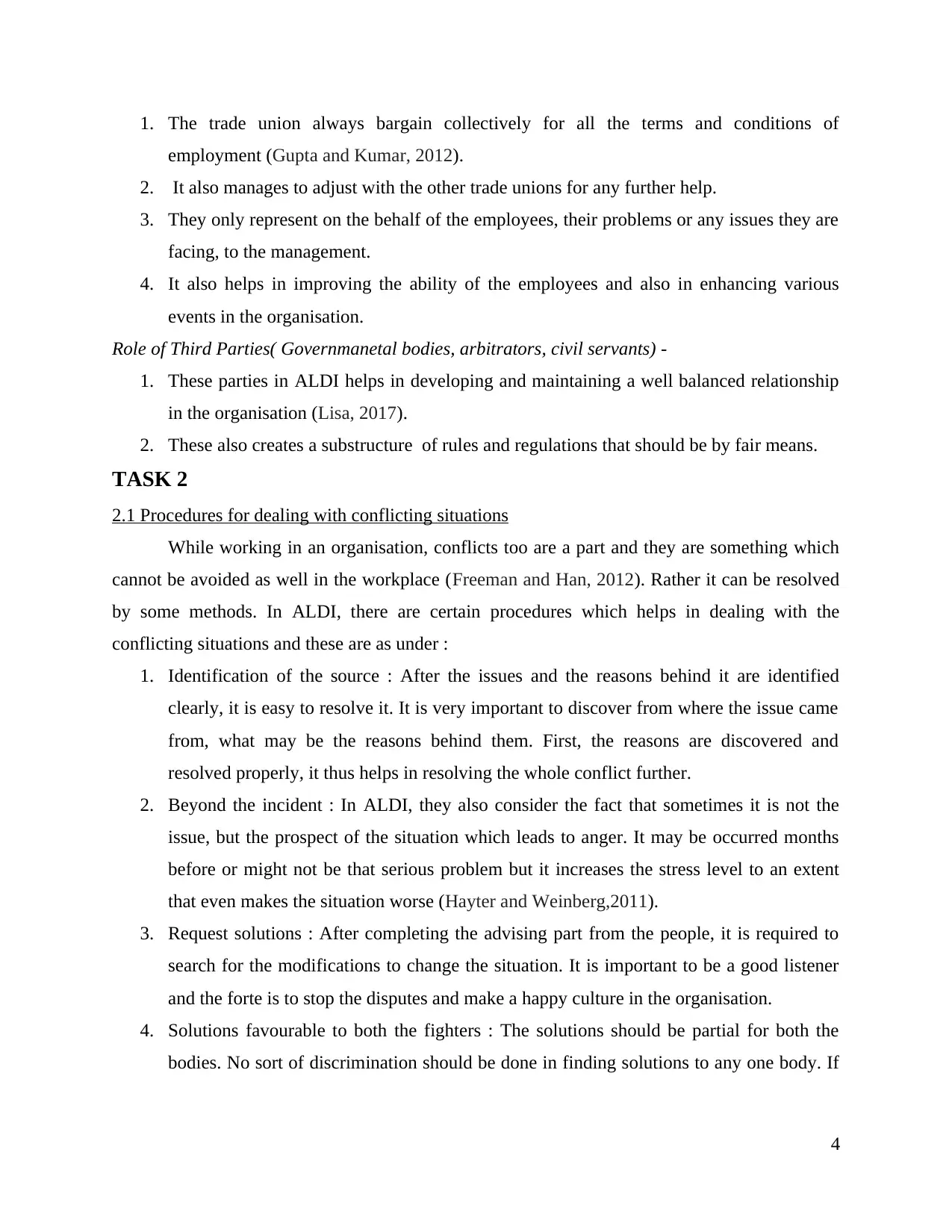
1. The trade union always bargain collectively for all the terms and conditions of
employment (Gupta and Kumar, 2012).
2. It also manages to adjust with the other trade unions for any further help.
3. They only represent on the behalf of the employees, their problems or any issues they are
facing, to the management.
4. It also helps in improving the ability of the employees and also in enhancing various
events in the organisation.
Role of Third Parties( Governmanetal bodies, arbitrators, civil servants) -
1. These parties in ALDI helps in developing and maintaining a well balanced relationship
in the organisation (Lisa, 2017).
2. These also creates a substructure of rules and regulations that should be by fair means.
TASK 2
2.1 Procedures for dealing with conflicting situations
While working in an organisation, conflicts too are a part and they are something which
cannot be avoided as well in the workplace (Freeman and Han, 2012). Rather it can be resolved
by some methods. In ALDI, there are certain procedures which helps in dealing with the
conflicting situations and these are as under :
1. Identification of the source : After the issues and the reasons behind it are identified
clearly, it is easy to resolve it. It is very important to discover from where the issue came
from, what may be the reasons behind them. First, the reasons are discovered and
resolved properly, it thus helps in resolving the whole conflict further.
2. Beyond the incident : In ALDI, they also consider the fact that sometimes it is not the
issue, but the prospect of the situation which leads to anger. It may be occurred months
before or might not be that serious problem but it increases the stress level to an extent
that even makes the situation worse (Hayter and Weinberg,2011).
3. Request solutions : After completing the advising part from the people, it is required to
search for the modifications to change the situation. It is important to be a good listener
and the forte is to stop the disputes and make a happy culture in the organisation.
4. Solutions favourable to both the fighters : The solutions should be partial for both the
bodies. No sort of discrimination should be done in finding solutions to any one body. If
4
employment (Gupta and Kumar, 2012).
2. It also manages to adjust with the other trade unions for any further help.
3. They only represent on the behalf of the employees, their problems or any issues they are
facing, to the management.
4. It also helps in improving the ability of the employees and also in enhancing various
events in the organisation.
Role of Third Parties( Governmanetal bodies, arbitrators, civil servants) -
1. These parties in ALDI helps in developing and maintaining a well balanced relationship
in the organisation (Lisa, 2017).
2. These also creates a substructure of rules and regulations that should be by fair means.
TASK 2
2.1 Procedures for dealing with conflicting situations
While working in an organisation, conflicts too are a part and they are something which
cannot be avoided as well in the workplace (Freeman and Han, 2012). Rather it can be resolved
by some methods. In ALDI, there are certain procedures which helps in dealing with the
conflicting situations and these are as under :
1. Identification of the source : After the issues and the reasons behind it are identified
clearly, it is easy to resolve it. It is very important to discover from where the issue came
from, what may be the reasons behind them. First, the reasons are discovered and
resolved properly, it thus helps in resolving the whole conflict further.
2. Beyond the incident : In ALDI, they also consider the fact that sometimes it is not the
issue, but the prospect of the situation which leads to anger. It may be occurred months
before or might not be that serious problem but it increases the stress level to an extent
that even makes the situation worse (Hayter and Weinberg,2011).
3. Request solutions : After completing the advising part from the people, it is required to
search for the modifications to change the situation. It is important to be a good listener
and the forte is to stop the disputes and make a happy culture in the organisation.
4. Solutions favourable to both the fighters : The solutions should be partial for both the
bodies. No sort of discrimination should be done in finding solutions to any one body. If
4
⊘ This is a preview!⊘
Do you want full access?
Subscribe today to unlock all pages.

Trusted by 1+ million students worldwide
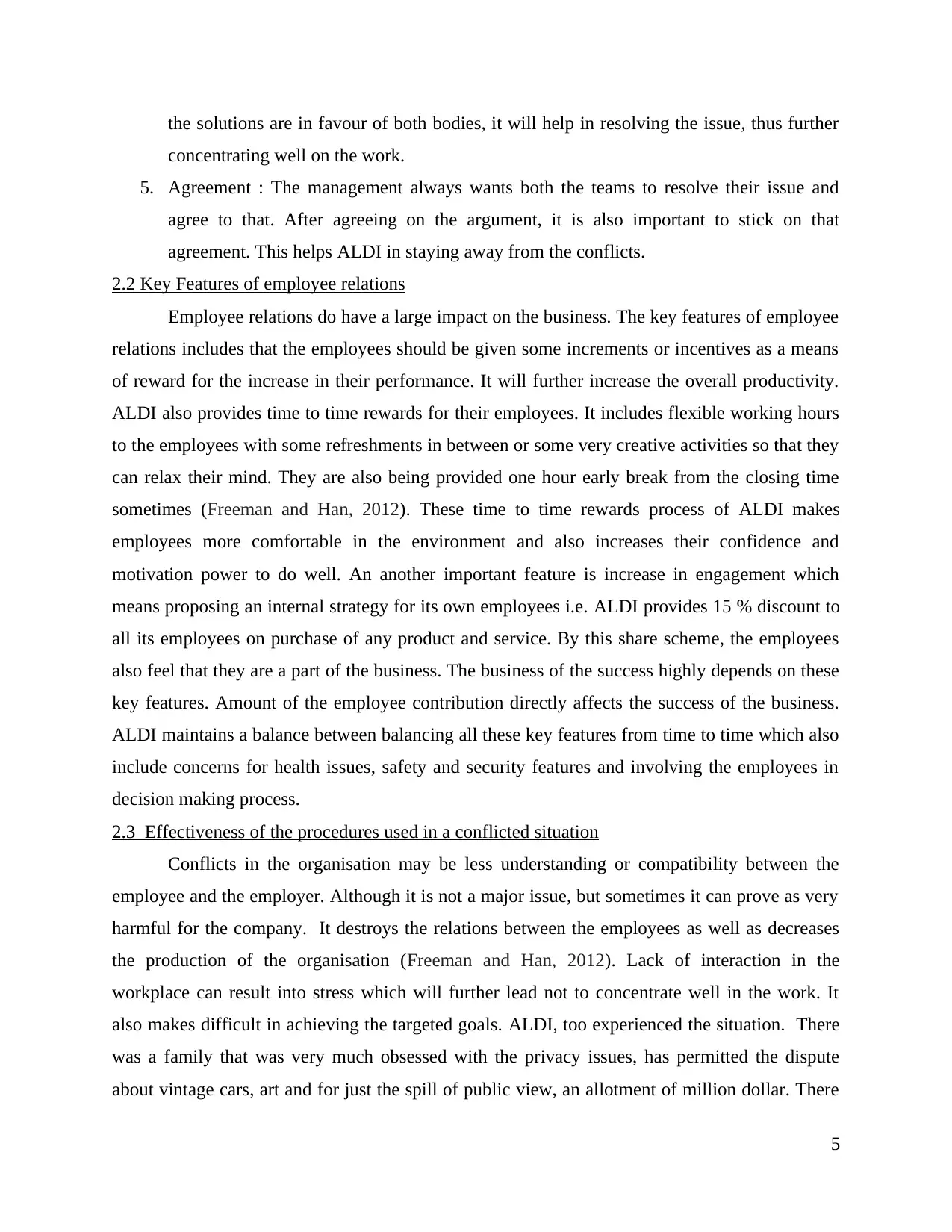
the solutions are in favour of both bodies, it will help in resolving the issue, thus further
concentrating well on the work.
5. Agreement : The management always wants both the teams to resolve their issue and
agree to that. After agreeing on the argument, it is also important to stick on that
agreement. This helps ALDI in staying away from the conflicts.
2.2 Key Features of employee relations
Employee relations do have a large impact on the business. The key features of employee
relations includes that the employees should be given some increments or incentives as a means
of reward for the increase in their performance. It will further increase the overall productivity.
ALDI also provides time to time rewards for their employees. It includes flexible working hours
to the employees with some refreshments in between or some very creative activities so that they
can relax their mind. They are also being provided one hour early break from the closing time
sometimes (Freeman and Han, 2012). These time to time rewards process of ALDI makes
employees more comfortable in the environment and also increases their confidence and
motivation power to do well. An another important feature is increase in engagement which
means proposing an internal strategy for its own employees i.e. ALDI provides 15 % discount to
all its employees on purchase of any product and service. By this share scheme, the employees
also feel that they are a part of the business. The business of the success highly depends on these
key features. Amount of the employee contribution directly affects the success of the business.
ALDI maintains a balance between balancing all these key features from time to time which also
include concerns for health issues, safety and security features and involving the employees in
decision making process.
2.3 Effectiveness of the procedures used in a conflicted situation
Conflicts in the organisation may be less understanding or compatibility between the
employee and the employer. Although it is not a major issue, but sometimes it can prove as very
harmful for the company. It destroys the relations between the employees as well as decreases
the production of the organisation (Freeman and Han, 2012). Lack of interaction in the
workplace can result into stress which will further lead not to concentrate well in the work. It
also makes difficult in achieving the targeted goals. ALDI, too experienced the situation. There
was a family that was very much obsessed with the privacy issues, has permitted the dispute
about vintage cars, art and for just the spill of public view, an allotment of million dollar. There
5
concentrating well on the work.
5. Agreement : The management always wants both the teams to resolve their issue and
agree to that. After agreeing on the argument, it is also important to stick on that
agreement. This helps ALDI in staying away from the conflicts.
2.2 Key Features of employee relations
Employee relations do have a large impact on the business. The key features of employee
relations includes that the employees should be given some increments or incentives as a means
of reward for the increase in their performance. It will further increase the overall productivity.
ALDI also provides time to time rewards for their employees. It includes flexible working hours
to the employees with some refreshments in between or some very creative activities so that they
can relax their mind. They are also being provided one hour early break from the closing time
sometimes (Freeman and Han, 2012). These time to time rewards process of ALDI makes
employees more comfortable in the environment and also increases their confidence and
motivation power to do well. An another important feature is increase in engagement which
means proposing an internal strategy for its own employees i.e. ALDI provides 15 % discount to
all its employees on purchase of any product and service. By this share scheme, the employees
also feel that they are a part of the business. The business of the success highly depends on these
key features. Amount of the employee contribution directly affects the success of the business.
ALDI maintains a balance between balancing all these key features from time to time which also
include concerns for health issues, safety and security features and involving the employees in
decision making process.
2.3 Effectiveness of the procedures used in a conflicted situation
Conflicts in the organisation may be less understanding or compatibility between the
employee and the employer. Although it is not a major issue, but sometimes it can prove as very
harmful for the company. It destroys the relations between the employees as well as decreases
the production of the organisation (Freeman and Han, 2012). Lack of interaction in the
workplace can result into stress which will further lead not to concentrate well in the work. It
also makes difficult in achieving the targeted goals. ALDI, too experienced the situation. There
was a family that was very much obsessed with the privacy issues, has permitted the dispute
about vintage cars, art and for just the spill of public view, an allotment of million dollar. There
5
Paraphrase This Document
Need a fresh take? Get an instant paraphrase of this document with our AI Paraphraser
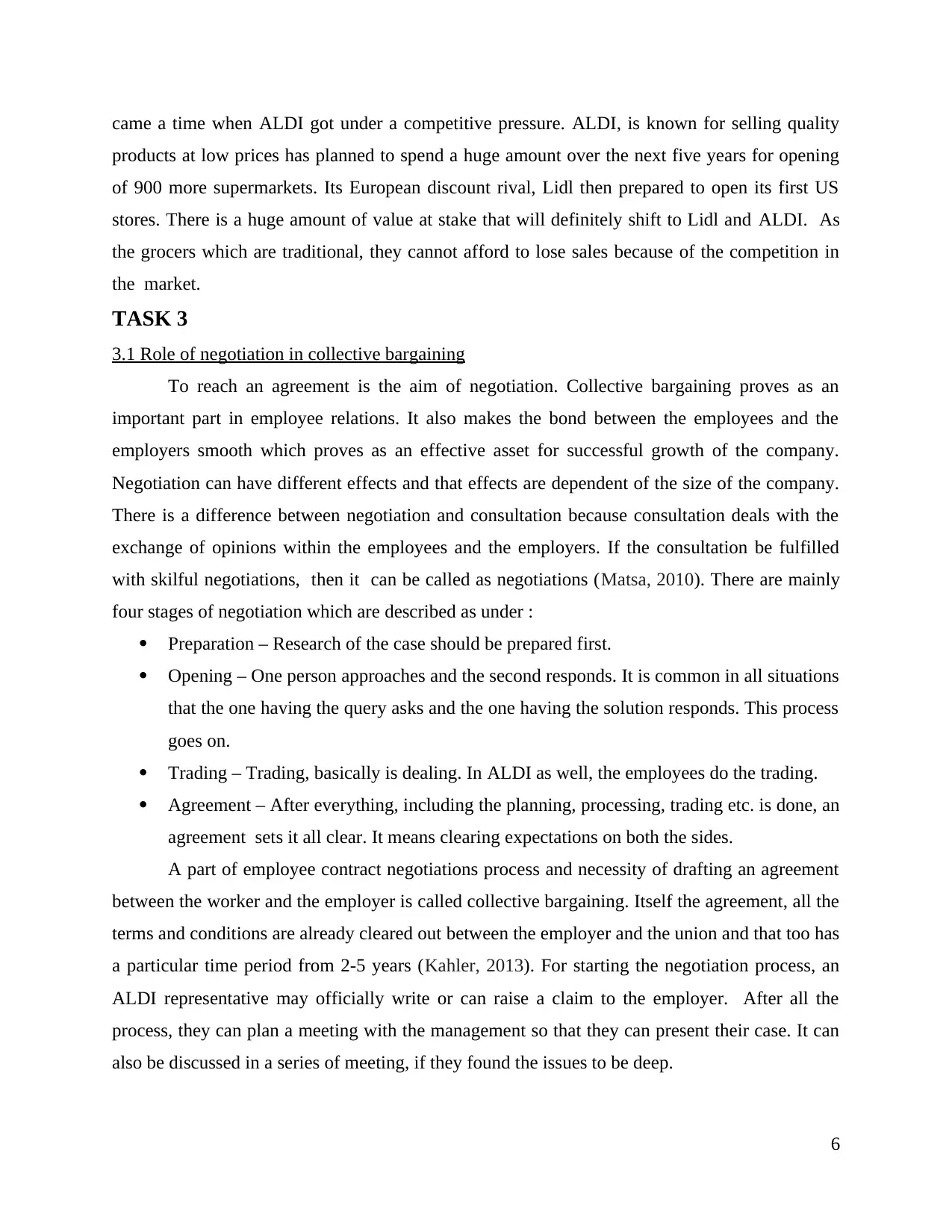
came a time when ALDI got under a competitive pressure. ALDI, is known for selling quality
products at low prices has planned to spend a huge amount over the next five years for opening
of 900 more supermarkets. Its European discount rival, Lidl then prepared to open its first US
stores. There is a huge amount of value at stake that will definitely shift to Lidl and ALDI. As
the grocers which are traditional, they cannot afford to lose sales because of the competition in
the market.
TASK 3
3.1 Role of negotiation in collective bargaining
To reach an agreement is the aim of negotiation. Collective bargaining proves as an
important part in employee relations. It also makes the bond between the employees and the
employers smooth which proves as an effective asset for successful growth of the company.
Negotiation can have different effects and that effects are dependent of the size of the company.
There is a difference between negotiation and consultation because consultation deals with the
exchange of opinions within the employees and the employers. If the consultation be fulfilled
with skilful negotiations, then it can be called as negotiations (Matsa, 2010). There are mainly
four stages of negotiation which are described as under :
Preparation – Research of the case should be prepared first.
Opening – One person approaches and the second responds. It is common in all situations
that the one having the query asks and the one having the solution responds. This process
goes on.
Trading – Trading, basically is dealing. In ALDI as well, the employees do the trading.
Agreement – After everything, including the planning, processing, trading etc. is done, an
agreement sets it all clear. It means clearing expectations on both the sides.
A part of employee contract negotiations process and necessity of drafting an agreement
between the worker and the employer is called collective bargaining. Itself the agreement, all the
terms and conditions are already cleared out between the employer and the union and that too has
a particular time period from 2-5 years (Kahler, 2013). For starting the negotiation process, an
ALDI representative may officially write or can raise a claim to the employer. After all the
process, they can plan a meeting with the management so that they can present their case. It can
also be discussed in a series of meeting, if they found the issues to be deep.
6
products at low prices has planned to spend a huge amount over the next five years for opening
of 900 more supermarkets. Its European discount rival, Lidl then prepared to open its first US
stores. There is a huge amount of value at stake that will definitely shift to Lidl and ALDI. As
the grocers which are traditional, they cannot afford to lose sales because of the competition in
the market.
TASK 3
3.1 Role of negotiation in collective bargaining
To reach an agreement is the aim of negotiation. Collective bargaining proves as an
important part in employee relations. It also makes the bond between the employees and the
employers smooth which proves as an effective asset for successful growth of the company.
Negotiation can have different effects and that effects are dependent of the size of the company.
There is a difference between negotiation and consultation because consultation deals with the
exchange of opinions within the employees and the employers. If the consultation be fulfilled
with skilful negotiations, then it can be called as negotiations (Matsa, 2010). There are mainly
four stages of negotiation which are described as under :
Preparation – Research of the case should be prepared first.
Opening – One person approaches and the second responds. It is common in all situations
that the one having the query asks and the one having the solution responds. This process
goes on.
Trading – Trading, basically is dealing. In ALDI as well, the employees do the trading.
Agreement – After everything, including the planning, processing, trading etc. is done, an
agreement sets it all clear. It means clearing expectations on both the sides.
A part of employee contract negotiations process and necessity of drafting an agreement
between the worker and the employer is called collective bargaining. Itself the agreement, all the
terms and conditions are already cleared out between the employer and the union and that too has
a particular time period from 2-5 years (Kahler, 2013). For starting the negotiation process, an
ALDI representative may officially write or can raise a claim to the employer. After all the
process, they can plan a meeting with the management so that they can present their case. It can
also be discussed in a series of meeting, if they found the issues to be deep.
6
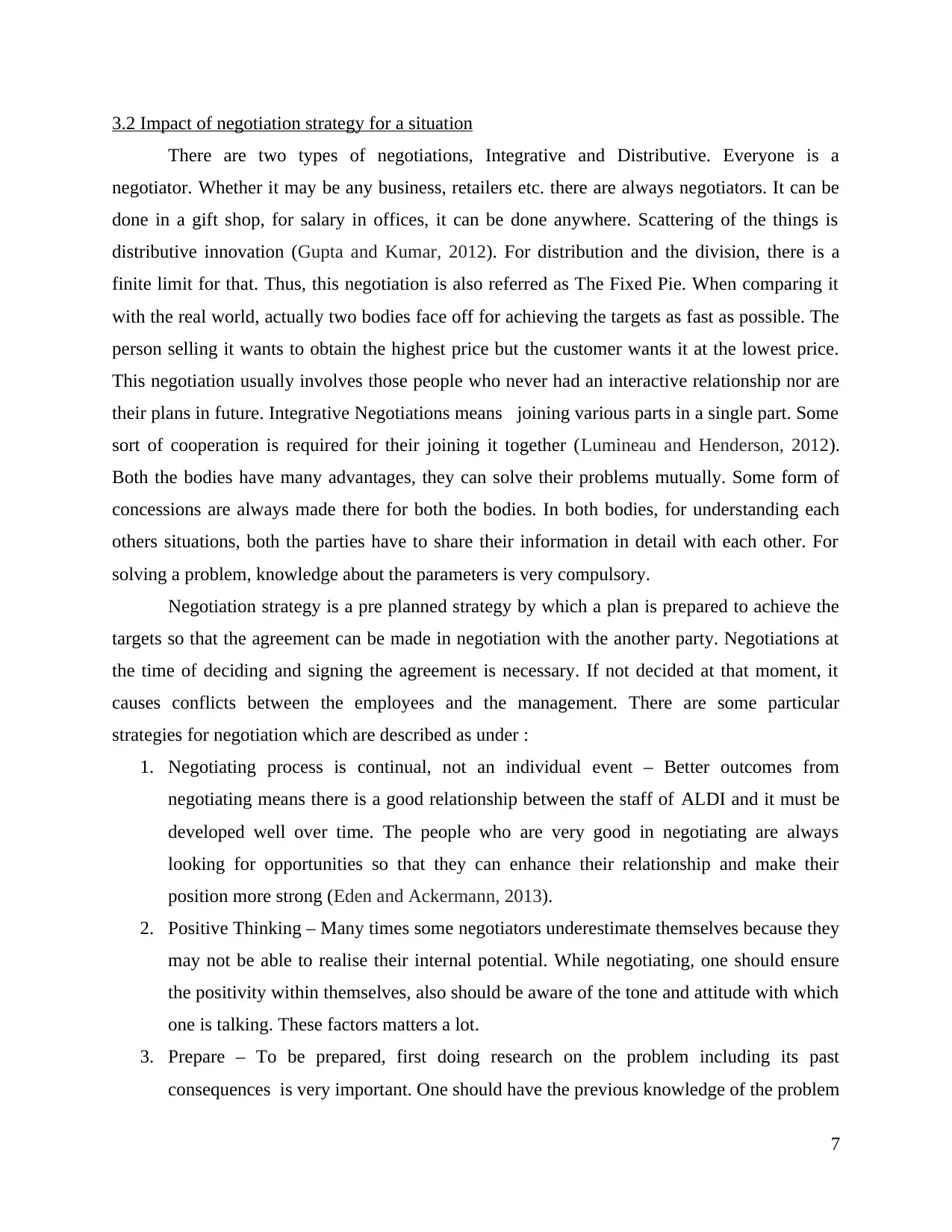
3.2 Impact of negotiation strategy for a situation
There are two types of negotiations, Integrative and Distributive. Everyone is a
negotiator. Whether it may be any business, retailers etc. there are always negotiators. It can be
done in a gift shop, for salary in offices, it can be done anywhere. Scattering of the things is
distributive innovation (Gupta and Kumar, 2012). For distribution and the division, there is a
finite limit for that. Thus, this negotiation is also referred as The Fixed Pie. When comparing it
with the real world, actually two bodies face off for achieving the targets as fast as possible. The
person selling it wants to obtain the highest price but the customer wants it at the lowest price.
This negotiation usually involves those people who never had an interactive relationship nor are
their plans in future. Integrative Negotiations means joining various parts in a single part. Some
sort of cooperation is required for their joining it together (Lumineau and Henderson, 2012).
Both the bodies have many advantages, they can solve their problems mutually. Some form of
concessions are always made there for both the bodies. In both bodies, for understanding each
others situations, both the parties have to share their information in detail with each other. For
solving a problem, knowledge about the parameters is very compulsory.
Negotiation strategy is a pre planned strategy by which a plan is prepared to achieve the
targets so that the agreement can be made in negotiation with the another party. Negotiations at
the time of deciding and signing the agreement is necessary. If not decided at that moment, it
causes conflicts between the employees and the management. There are some particular
strategies for negotiation which are described as under :
1. Negotiating process is continual, not an individual event – Better outcomes from
negotiating means there is a good relationship between the staff of ALDI and it must be
developed well over time. The people who are very good in negotiating are always
looking for opportunities so that they can enhance their relationship and make their
position more strong (Eden and Ackermann, 2013).
2. Positive Thinking – Many times some negotiators underestimate themselves because they
may not be able to realise their internal potential. While negotiating, one should ensure
the positivity within themselves, also should be aware of the tone and attitude with which
one is talking. These factors matters a lot.
3. Prepare – To be prepared, first doing research on the problem including its past
consequences is very important. One should have the previous knowledge of the problem
7
There are two types of negotiations, Integrative and Distributive. Everyone is a
negotiator. Whether it may be any business, retailers etc. there are always negotiators. It can be
done in a gift shop, for salary in offices, it can be done anywhere. Scattering of the things is
distributive innovation (Gupta and Kumar, 2012). For distribution and the division, there is a
finite limit for that. Thus, this negotiation is also referred as The Fixed Pie. When comparing it
with the real world, actually two bodies face off for achieving the targets as fast as possible. The
person selling it wants to obtain the highest price but the customer wants it at the lowest price.
This negotiation usually involves those people who never had an interactive relationship nor are
their plans in future. Integrative Negotiations means joining various parts in a single part. Some
sort of cooperation is required for their joining it together (Lumineau and Henderson, 2012).
Both the bodies have many advantages, they can solve their problems mutually. Some form of
concessions are always made there for both the bodies. In both bodies, for understanding each
others situations, both the parties have to share their information in detail with each other. For
solving a problem, knowledge about the parameters is very compulsory.
Negotiation strategy is a pre planned strategy by which a plan is prepared to achieve the
targets so that the agreement can be made in negotiation with the another party. Negotiations at
the time of deciding and signing the agreement is necessary. If not decided at that moment, it
causes conflicts between the employees and the management. There are some particular
strategies for negotiation which are described as under :
1. Negotiating process is continual, not an individual event – Better outcomes from
negotiating means there is a good relationship between the staff of ALDI and it must be
developed well over time. The people who are very good in negotiating are always
looking for opportunities so that they can enhance their relationship and make their
position more strong (Eden and Ackermann, 2013).
2. Positive Thinking – Many times some negotiators underestimate themselves because they
may not be able to realise their internal potential. While negotiating, one should ensure
the positivity within themselves, also should be aware of the tone and attitude with which
one is talking. These factors matters a lot.
3. Prepare – To be prepared, first doing research on the problem including its past
consequences is very important. One should have the previous knowledge of the problem
7
⊘ This is a preview!⊘
Do you want full access?
Subscribe today to unlock all pages.

Trusted by 1+ million students worldwide

in detail. The more better one is having the idea of the situation, one can negotiate better.
Practice is important to analyse the situation well.
4. Keep in mind the best as well the worst outcome – Before the negotiation, it is important
to analyse personally the best and the worst outcomes. One should be prepare for the both
(Ferguson and Reio., 2010).
5. Be articulate – Being articulate is important. A positive attitude while negotiating makes
one shine. Being direct at the time of presenting some situation and discussion on the
consequences is important (Gupta and Kumar, 2012).
6. Proper give and take – Give and take is an old policy. When an employee is giving
something to the company, it is obvious that the employee will expect the same in return
from the company.
TASK 4
4.1 How EU influenced industrial democracy in UK
For the management of the organisation, participation of the employees in discussing
decisions and sharing responsibilities is called industrial democracy. It has been well established
in many of the European countries but has not been developed yet because of the conflicting
relations between the employees and employers. The European codification is known for
encouraging the role of employees in a better decision making. It has also influenced 'partner
based relationships' which says that the employees, unions and the management should work
together for achieving the targeted goals. This relationship in the British industry is a suitable
example of better employee-manager relationships in the organisation. Their present goal is to
establish there, the importance of involvement of more employees in sharing decisions with each
other which resulted in making the process more practical (Van Buren,Greenwood and Sheehan,
2011). It influenced the employees for contributing more to the work, thus increasing the growth
of the organisation. Works council constitutes the employees depicting the personnel with the
other employees. Their work is that they plan strategies for the long term objectives of the
business so that it can be improved more for any future prospects. Other Stakeholders and
partners can also contribute in the business. Shareholders usually shares schemes and options for
saving. These schemes also have helped many businesses in UK which were running at the stake
of loosing their shares in the business. There is a fear in the European market of increasing the
'wage dumping' , a process in which first the migrant employees are selected for employment and
8
Practice is important to analyse the situation well.
4. Keep in mind the best as well the worst outcome – Before the negotiation, it is important
to analyse personally the best and the worst outcomes. One should be prepare for the both
(Ferguson and Reio., 2010).
5. Be articulate – Being articulate is important. A positive attitude while negotiating makes
one shine. Being direct at the time of presenting some situation and discussion on the
consequences is important (Gupta and Kumar, 2012).
6. Proper give and take – Give and take is an old policy. When an employee is giving
something to the company, it is obvious that the employee will expect the same in return
from the company.
TASK 4
4.1 How EU influenced industrial democracy in UK
For the management of the organisation, participation of the employees in discussing
decisions and sharing responsibilities is called industrial democracy. It has been well established
in many of the European countries but has not been developed yet because of the conflicting
relations between the employees and employers. The European codification is known for
encouraging the role of employees in a better decision making. It has also influenced 'partner
based relationships' which says that the employees, unions and the management should work
together for achieving the targeted goals. This relationship in the British industry is a suitable
example of better employee-manager relationships in the organisation. Their present goal is to
establish there, the importance of involvement of more employees in sharing decisions with each
other which resulted in making the process more practical (Van Buren,Greenwood and Sheehan,
2011). It influenced the employees for contributing more to the work, thus increasing the growth
of the organisation. Works council constitutes the employees depicting the personnel with the
other employees. Their work is that they plan strategies for the long term objectives of the
business so that it can be improved more for any future prospects. Other Stakeholders and
partners can also contribute in the business. Shareholders usually shares schemes and options for
saving. These schemes also have helped many businesses in UK which were running at the stake
of loosing their shares in the business. There is a fear in the European market of increasing the
'wage dumping' , a process in which first the migrant employees are selected for employment and
8
Paraphrase This Document
Need a fresh take? Get an instant paraphrase of this document with our AI Paraphraser
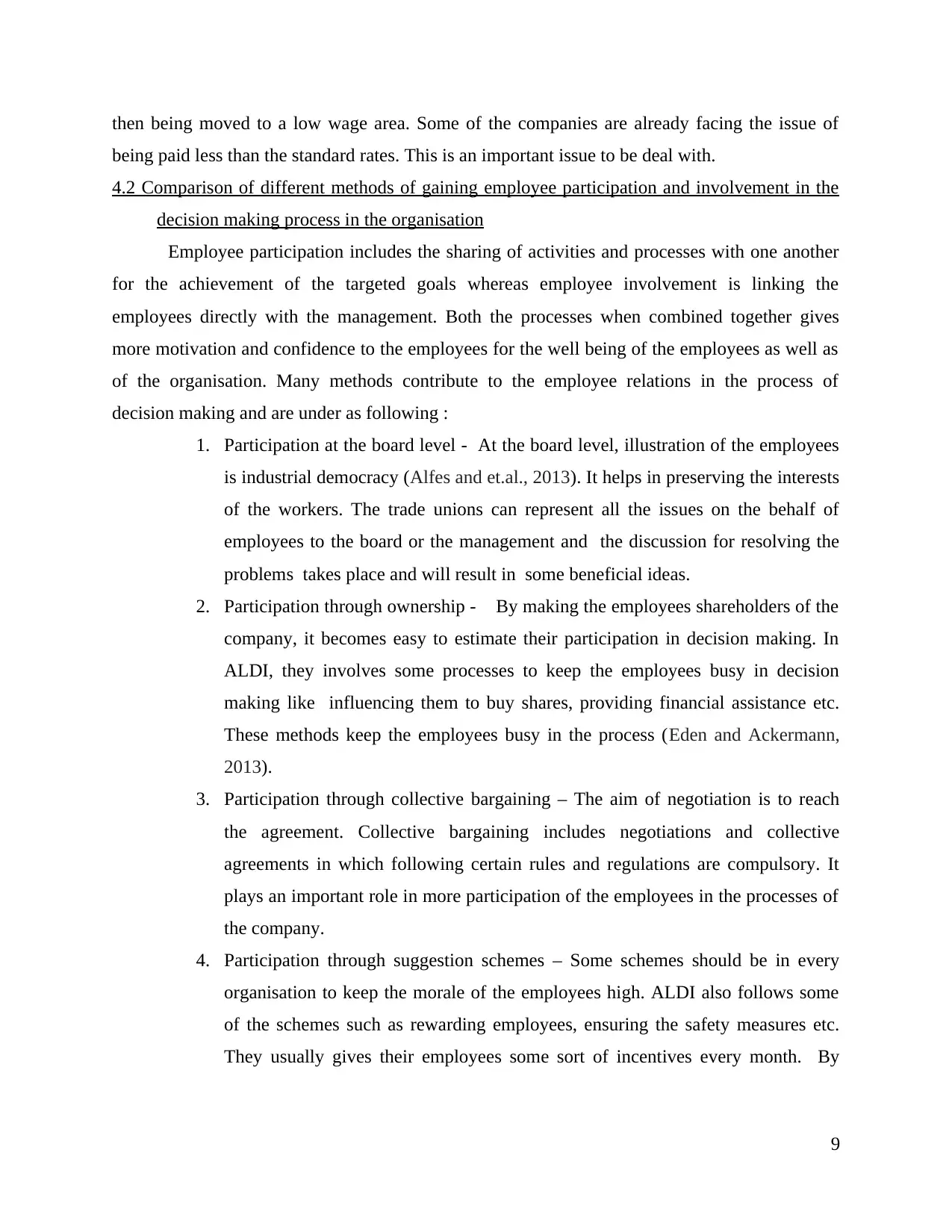
then being moved to a low wage area. Some of the companies are already facing the issue of
being paid less than the standard rates. This is an important issue to be deal with.
4.2 Comparison of different methods of gaining employee participation and involvement in the
decision making process in the organisation
Employee participation includes the sharing of activities and processes with one another
for the achievement of the targeted goals whereas employee involvement is linking the
employees directly with the management. Both the processes when combined together gives
more motivation and confidence to the employees for the well being of the employees as well as
of the organisation. Many methods contribute to the employee relations in the process of
decision making and are under as following :
1. Participation at the board level - At the board level, illustration of the employees
is industrial democracy (Alfes and et.al., 2013). It helps in preserving the interests
of the workers. The trade unions can represent all the issues on the behalf of
employees to the board or the management and the discussion for resolving the
problems takes place and will result in some beneficial ideas.
2. Participation through ownership - By making the employees shareholders of the
company, it becomes easy to estimate their participation in decision making. In
ALDI, they involves some processes to keep the employees busy in decision
making like influencing them to buy shares, providing financial assistance etc.
These methods keep the employees busy in the process (Eden and Ackermann,
2013).
3. Participation through collective bargaining – The aim of negotiation is to reach
the agreement. Collective bargaining includes negotiations and collective
agreements in which following certain rules and regulations are compulsory. It
plays an important role in more participation of the employees in the processes of
the company.
4. Participation through suggestion schemes – Some schemes should be in every
organisation to keep the morale of the employees high. ALDI also follows some
of the schemes such as rewarding employees, ensuring the safety measures etc.
They usually gives their employees some sort of incentives every month. By
9
being paid less than the standard rates. This is an important issue to be deal with.
4.2 Comparison of different methods of gaining employee participation and involvement in the
decision making process in the organisation
Employee participation includes the sharing of activities and processes with one another
for the achievement of the targeted goals whereas employee involvement is linking the
employees directly with the management. Both the processes when combined together gives
more motivation and confidence to the employees for the well being of the employees as well as
of the organisation. Many methods contribute to the employee relations in the process of
decision making and are under as following :
1. Participation at the board level - At the board level, illustration of the employees
is industrial democracy (Alfes and et.al., 2013). It helps in preserving the interests
of the workers. The trade unions can represent all the issues on the behalf of
employees to the board or the management and the discussion for resolving the
problems takes place and will result in some beneficial ideas.
2. Participation through ownership - By making the employees shareholders of the
company, it becomes easy to estimate their participation in decision making. In
ALDI, they involves some processes to keep the employees busy in decision
making like influencing them to buy shares, providing financial assistance etc.
These methods keep the employees busy in the process (Eden and Ackermann,
2013).
3. Participation through collective bargaining – The aim of negotiation is to reach
the agreement. Collective bargaining includes negotiations and collective
agreements in which following certain rules and regulations are compulsory. It
plays an important role in more participation of the employees in the processes of
the company.
4. Participation through suggestion schemes – Some schemes should be in every
organisation to keep the morale of the employees high. ALDI also follows some
of the schemes such as rewarding employees, ensuring the safety measures etc.
They usually gives their employees some sort of incentives every month. By
9
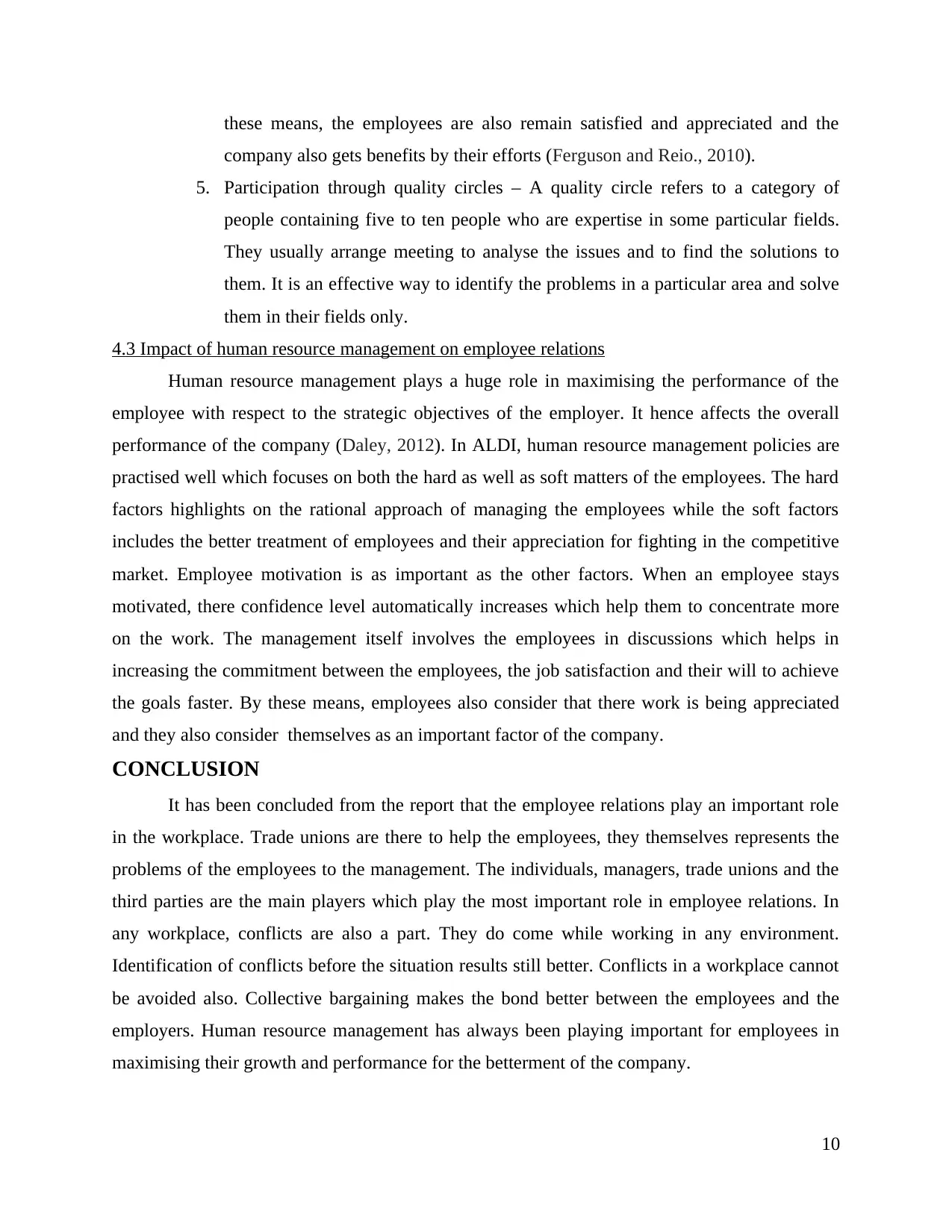
these means, the employees are also remain satisfied and appreciated and the
company also gets benefits by their efforts (Ferguson and Reio., 2010).
5. Participation through quality circles – A quality circle refers to a category of
people containing five to ten people who are expertise in some particular fields.
They usually arrange meeting to analyse the issues and to find the solutions to
them. It is an effective way to identify the problems in a particular area and solve
them in their fields only.
4.3 Impact of human resource management on employee relations
Human resource management plays a huge role in maximising the performance of the
employee with respect to the strategic objectives of the employer. It hence affects the overall
performance of the company (Daley, 2012). In ALDI, human resource management policies are
practised well which focuses on both the hard as well as soft matters of the employees. The hard
factors highlights on the rational approach of managing the employees while the soft factors
includes the better treatment of employees and their appreciation for fighting in the competitive
market. Employee motivation is as important as the other factors. When an employee stays
motivated, there confidence level automatically increases which help them to concentrate more
on the work. The management itself involves the employees in discussions which helps in
increasing the commitment between the employees, the job satisfaction and their will to achieve
the goals faster. By these means, employees also consider that there work is being appreciated
and they also consider themselves as an important factor of the company.
CONCLUSION
It has been concluded from the report that the employee relations play an important role
in the workplace. Trade unions are there to help the employees, they themselves represents the
problems of the employees to the management. The individuals, managers, trade unions and the
third parties are the main players which play the most important role in employee relations. In
any workplace, conflicts are also a part. They do come while working in any environment.
Identification of conflicts before the situation results still better. Conflicts in a workplace cannot
be avoided also. Collective bargaining makes the bond better between the employees and the
employers. Human resource management has always been playing important for employees in
maximising their growth and performance for the betterment of the company.
10
company also gets benefits by their efforts (Ferguson and Reio., 2010).
5. Participation through quality circles – A quality circle refers to a category of
people containing five to ten people who are expertise in some particular fields.
They usually arrange meeting to analyse the issues and to find the solutions to
them. It is an effective way to identify the problems in a particular area and solve
them in their fields only.
4.3 Impact of human resource management on employee relations
Human resource management plays a huge role in maximising the performance of the
employee with respect to the strategic objectives of the employer. It hence affects the overall
performance of the company (Daley, 2012). In ALDI, human resource management policies are
practised well which focuses on both the hard as well as soft matters of the employees. The hard
factors highlights on the rational approach of managing the employees while the soft factors
includes the better treatment of employees and their appreciation for fighting in the competitive
market. Employee motivation is as important as the other factors. When an employee stays
motivated, there confidence level automatically increases which help them to concentrate more
on the work. The management itself involves the employees in discussions which helps in
increasing the commitment between the employees, the job satisfaction and their will to achieve
the goals faster. By these means, employees also consider that there work is being appreciated
and they also consider themselves as an important factor of the company.
CONCLUSION
It has been concluded from the report that the employee relations play an important role
in the workplace. Trade unions are there to help the employees, they themselves represents the
problems of the employees to the management. The individuals, managers, trade unions and the
third parties are the main players which play the most important role in employee relations. In
any workplace, conflicts are also a part. They do come while working in any environment.
Identification of conflicts before the situation results still better. Conflicts in a workplace cannot
be avoided also. Collective bargaining makes the bond better between the employees and the
employers. Human resource management has always been playing important for employees in
maximising their growth and performance for the betterment of the company.
10
⊘ This is a preview!⊘
Do you want full access?
Subscribe today to unlock all pages.

Trusted by 1+ million students worldwide
1 out of 14
Related Documents
Your All-in-One AI-Powered Toolkit for Academic Success.
+13062052269
info@desklib.com
Available 24*7 on WhatsApp / Email
![[object Object]](/_next/static/media/star-bottom.7253800d.svg)
Unlock your academic potential
Copyright © 2020–2025 A2Z Services. All Rights Reserved. Developed and managed by ZUCOL.





